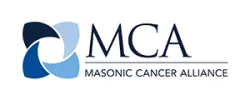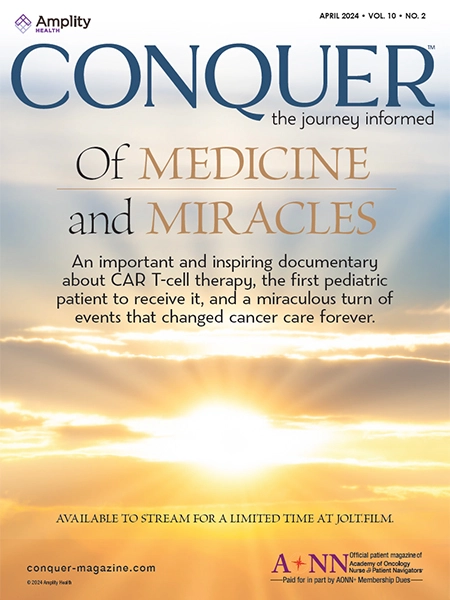
Although Sunday only allowed for a half-day of events, its bounty of sessions provided a grand finale to the 2019 AONN+ Midyear Conference. General sessions focused on hot topics such as cancer legal issues, sexuality and cancer, and cancer nutrition. Four breakout sessions gave attendees opportunities to learn more about new developments in hematologic cancers, primary prevention, improving collaboration among disciplines, and understanding neuroendocrine and colorectal cancers.
Cancer-Related Legal Issues: Arming Patients with Information
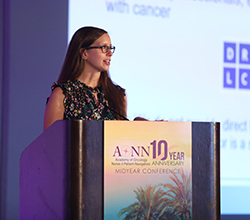
Cancer deals a devastating blow to all those affected by it. It can impact every aspect of one’s life, and efforts to manage these various areas while undergoing treatment and living with the disease can be overwhelming. A thorough understanding of the legal issues that pertain to patients with cancer can help reduce the burden for them and their families. Stephanie Fajuri, JD, Director of the Cancer Legal Resource Center (CLRC), a Disability Rights Legal Center site, Los Angeles, CA, outlined these issues and how to manage them. This session was full of invaluable information and provided numerous resources.
Ms Fajuri asked for a show of hands to gauge how many in the audience were familiar with the CLRC, and she was pleased to see that there was a positive response. The CLRC is a national organization with the mission to offer free information and resources to anyone with a cancer-related legal issue. There is a free legal telephone hotline at (866) THE-CLRC and a website with an intake questionnaire at CLRCintake.org. She cautioned however, that it does not provide legal representation or give legal advice. If anyone should need such services, they are advised to consult a lawyer. Among the services it offers are free material and training and free webinars. For example, an upcoming webinar will be devoted to the health-related problems immigrants face. Other topics include consumer law issues and managing debt, medical bills, and credit reporting. The CLRC is a national organization, but there exist many state organizations as well and they vary by state in what they are equipped to offer.
Employment is a major cause of concern for a patient with cancer. As 49% of Americans receive healthcare coverage through their employer, work and healthcare are closely tied together. Knowing one’s rights and responsibilities goes a long way toward managing a work situation with minimal distress. And Ms Fajuri added that it is the patient’s responsibility to know and understand their healthcare coverage and not rely on their physician or other provider to know its provisions.
One of the most important things to know is that disclosing a cancer diagnosis is never required—especially during a job interview, Ms Fajuri advised. In addition, she said, while patients should equip themselves with knowledge about state and federal employment laws, these should only be considered a baseline; many companies offer more benefits than are required by law.
Ms Fajuri illustrated her talk with case scenarios from real-world experience, and these were especially helpful in clarifying how the laws apply to individuals in different occupations, particularly those that are less easily adaptable to workplace provisions such as flextime or the ability to work remotely.
The Americans with Disabilities Act (ADA) and Family and Medical Leave Act (FMLA) are federal laws designed to protect employees. The ADA gives employees with disabilities the right to “reasonable accommodations” that will allow them to do their job. An accommodation is a change or adjustment to the work environment to let someone continue to work. Employers are required to negotiate in an interactive process to make reasonable accommodations. However, they are not required to hold an employee’s job for their return indefinitely.
An employee must request such accommodations before their work performance begins to suffer, Ms Fajuri noted. This provision is particularly important to recognize, because an employee may be subject to a negative work action for performance lapses that occurred prior to their disclosure of their illness. She gave an example of an employee who experienced fatigue and reported late for work due to it. After 3 latenesses, the employee was written up, but because she had not informed the employer of her illness, the work discipline was considered legal.
The FMLA provides 12 weeks of unpaid, job-protected leave for persons with serious health conditions or those caring for a parent, spouse, or child facing such conditions. While many believe that one must be employed “full time” in order to receive the benefit, it is actually less restrictive than it appears, so make certain to understand its requirements. Nevertheless, unpaid time away from work can cause financial hardship and may be out of reach of many.
Managing health insurance issues can be draining for patients with cancer. Ms Fajuri emphasized that the Affordable Care Act (ACA) is not dead. If patients need healthcare coverage, “it is not okay to charge people more for pre-existing conditions, to ask parents to disclose a diagnosis, etc.,” thus, patients are potentially still able to purchase insurance because much of the ACA remains in effect.
Although medical bills can be overwhelming, patients should know that these bills are negotiable. Patients should be encouraged to open their mail, even when they feel unable to address the bills within. Caution should be exercised when considering applying for loans or medical credit cards. Crowdfunding and other fundraising are viable options used by many, but in some cases, could jeopardize certain government benefits. Patients in fear of having their wages or bank accounts garnished should be advised that a debt collection lawsuit is necessary before these things can occur, Ms Fajuri said.
Advance planning is another area where legal issues come into play. Planning for property through wills, trusts, and powers of attorney to deal with financial matters is a necessary task for patients with cancer and their loved ones. Equally important are advance healthcare directives, which include powers of attorney for healthcare decisions, living wills, physician or medical orders for life-sustaining treatment, and knowing patients’ rights in end-of-life care.
With so much detailed information, and a topic that is central to the health of nearly all patients with cancer, there were ample questions that Ms Fajuri was happy to answer and encouraged all to reach out to her organization or similar state offices for more information and assistance with these complex issues.
Sexual Healing: Bringing Intimacy Back into the Lives of Women with Cancer
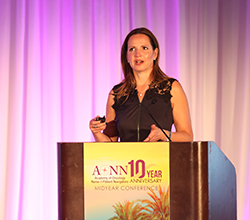
Considering the overall 5-year relative survival rate of 88.1% for breast cancer among women of all ages, most women with a diagnosis of breast cancer will become long-term survivors. Therefore, survivorship and quality-of-life issues are very important. Among the multitude of ways a cancer diagnosis and subsequent treatment impact those affected, sexuality is often overlooked. When one considers that approximately 50% of women with breast or gynecologic cancers will experience sexual dysfunction after treatment, the issue becomes difficult to ignore. Providing both an education and a multifaceted, patient-centered approach to issues of sexuality surrounding cancer, Leah S. Millheiser, MD, helped oncology navigators become better prepared to address a difficult issue for patients.
Dr Millheiser’s presentation covered the impact of a cancer diagnosis and its treatment of female sexual function, the difference in health and psychosocial concerns that affect premenopausal versus postmenopausal cancer survivors, and the intervention recommended for the management of sexual function concerns in the cancer survivor.
Issues of sexuality in cancer have multifactorial origins, and can be physiological, interpersonal, psychological, or sociocultural in nature. Dr Millheiser explained that treatment for many of the issues is available and that communication is the first line of relief. For women with breast or gynecologic cancers, problems with sexual function are typically loss of desire, pain with genital manipulation, difficulty reaching orgasm, vaginal dryness and/or pain, and vaginal shortening and/or narrowing. She emphasized the importance for patients to be open with their physicians regarding their symptoms.
Although sexual dysfunction affects women at all stages of life, younger women often see greater impacts, according to Dr Millheiser. Among women with breast cancer, younger women have more severe emotional distress than their older counterparts. Younger women also suffer greater psychological effects from the loss of a breast or poor breast appearance, which is why breast conservation is particularly important among this population. Potential infertility from cancer treatments can damage a woman’s self-image as a sexual person. Adding to the issue, premature menopause has the potential to cause vaginal atrophy, low libido, and decreased genital arousal. Because of these issues, women aged younger than 50 years have poorer quality of life and more frequent and severe depressive symptoms than older women facing breast cancer.
Keeping in mind that it takes two to tango, it makes perfect sense that partners of patients with cancer are also impacted. Among patients with reproductive cancer types, 84% of partners reported that their sexual relationship was affected; for nonreproductive cancer types, 76% of partners were affected. These effects stem from the impact of treatment, exhaustion from caring for their partner, and viewing the person with cancer as a patient rather than a sexual partner. Such problems can be compounded by diminished communication as a result of the partners trying to protect each other’s feelings. From there, conflicts could arise, making an intervention necessary to assist the couple in coping.
The treatments that have the greatest effects on sexual function are also the most common—chemotherapy, surgery, hormonal manipulation, and radiation therapy. Dr Millheiser outlined the potential effects of each, also explaining that other drugs prescribed to patients with cancer can have a deleterious impact on sexual function, including antianxiety, antinausea, and pain medications; neuromodulators; antidepressants; and sleep aids.
Patients with sexual dysfunction are not doomed to live with an unfulfilling or nonexistent sex life. Clinical interventions, such as pretreatment assessment of sexual function, counseling, and discussion of fertility; posttreatment body image counseling; and early treatment of vaginal symptoms all prove helpful, Dr Millheiser said.
Reframing the “new normal” for sex is integral to broaching intimacy after diagnosis or treatment. This involves becoming comfortable with changes in one’s body following surgery or radiation therapy. Wearing lingerie or doing some self-exploration can help with this. In addition, treating any sexual dysfunction in the partner is important, as is seeking therapy for any relationship difficulties. Pain medication should be taken prior to any planned sexual activity. Liberal use of lubricants and moisturizers also help to minimize discomfort. Minimizing emotional discomfort, including fear and anxiety, can be achieved by choosing a time when symptoms are well-controlled to engage in sex, as well as by resuming activity on a stepwise basis, Dr Millheiser advised. Patients should start with hugging and kissing, and then as comfort grows, move on to touching and, eventually, intercourse. Couples should remember that the overall goal is intimacy, which can be achieved in a variety of ways.
Low libido has multiple possible causes, and can be alleviated in a variety of ways. Drug treatments include flibanserin, bupropion, and buspirone. In addition, a supplement called ArginMax has shown promising results in a randomized controlled trial. Counseling, psychotherapy, and sex therapy can all be beneficial, as well.
Depending on whether hormones are safe for a particular patient, vaginal atrophy can be treated with topical estrogen or with lubricants. For patients with dyspareunia or vaginal stenosis, vaginal dilator therapy can be beneficial. Dr Millheiser mentioned that MonaLisa Touch® is an available laser treatment that can help with a variety of vaginal symptoms; however, the risks of such treatments must be weighed against their benefits.
Patients struggling to reach orgasm can benefit from masturbatory therapies and devices, along with Kegel exercises, topical estrogen if indicated, therapy, and mindfulness.
Dr Millheiser shared several online resources for additional information and reiterated that no matter what sexual issues a woman with cancer may face, it is important for her to know she is not alone, help is available, and that “communication” is key.
Eating Right with Cancer: Cutting Through Myths to the Meat of the Matter
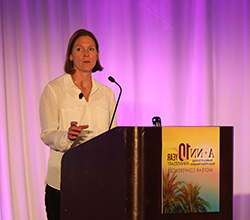
With the constant barrage of fad diets and news on nutrition breakthroughs, knowing what to eat for optimal health can be a confounding conundrum. For patients with cancer, nutrition knowledge is a crucial element of recovery, according to Natalie Ledesma, MS, RDN, CSO, CLT, who provided food for thought on the truths and myths of nutrition during a working lunch session.
Starting with some basics, Ms Ledesma provided a visual of what comprises a healthy plate—half fruits, vegetables, and healthy fats; one-quarter lean animal or plant protein; and one-quarter starchy vegetables or whole grains. She was pleased to see that the oncology navigators were enjoying a healthy lunch of salads, lean protein, and healthy grains. She added that people should aim to derive at least 80% of nutrients from plant-based sources. Compounds called phytochemicals that occur naturally in plant-based foods provide protective benefits against cancer and other diseases. Highlighting the various colors of fruits and vegetables, as well as the advantages of each, Ms Ledesma explained that a healthy diet is one that encompasses an array of colors.
Ms Ledesma continued to discuss popular “myths” surrounding food choices. She focused, first, on the myth that sugar causes cancer. The truth of the matter is, simply, that sugar is not healthy. Foods high in sugar typically lack nutritional value. The way such foods—especially those containing high-fructose corn syrup—are metabolized appears to increase fat mass and lead to metabolic disease. In addition, sugar consumption can lead to insulin resistance. Similar to a drug addiction, sugar creates a biochemical craving to consume more. Lastly, sugar consumption is linked with increased mortality risk. Ms Ledesma detailed the connection between insulin, glycemic control, and cancer, as well as metabolic syndrome and cancer.
Related to the sugar issue is the myth that artificial sweeteners are a healthier option. Although possible links with cancer have not been fully substantiated, studies have shown that the sugar substitutes promote weight gain and could contribute to heart disease, type 2 diabetes, and poor gut health.
Inflammation in the body has been associated with cancer, and this connection is no myth, it is a fact, according to Ms Ledesma. Those with high levels of inflammation have correspondingly high levels of C-reactive protein, which are common in several types of cancer and serve as a prognostic marker in patients with cancer. With proper diet and supplementation, including an adequate amount of essential fatty acids, patients can prevent inflammation, Ms Ledesma explained.
The discussion turned to what is trending on the diet front. Ms Ledesma noted that often what is trending may not be best for one’s health. Such is the myth that everyone should follow a low-fat or ketogenic diet. Although “low-fat” may sound good at face value, it translates to greater amounts of carbohydrates. In addition, foods touted as low-fat are often highly processed and filled with unhealthy ingredients, which can result in the exact opposite outcome for which one is aiming—weight gain and metabolic issues. Despite the popularity of the ketogenic diet, in which followers seek to reach a state of ketosis—a metabolic state in which the body uses ketones as its primary fuel—it is not beneficial for everyone, and can bring on side effects ranging from nausea and vomiting to renal damage and bone mineral loss. Nutrigenomics, a relatively new concept, is a whole-system philosophy that focuses on a person’s genetic makeup, biomarkers, and other clinical data to customize one’s diet to individual needs. Similar to precision medicine in its approach, nutrigenomics seeks to personalize nutrition.
As soy-based foods and beverages continue to grow in popularity, survivors of breast cancer and other cancers often steer clear of them because they have been warned of the risks involved with consuming these items. Although research on soy is inconclusive, it has been shown to decrease risk for recurrence of breast cancer and death. While Ms Ledesma said she would not necessarily recommend adding soy to one’s diet, she said it is perfectly safe to consume moderate amounts of organic, non–genetically modified soy products
The bottom line, she said, is that a healthy diet may help to prevent cancer, inhibit its growth, and reduce the risk for recurrence. For patients with cancer, she reiterated that such a diet consists of 8 to 10 colorful servings of fruits and vegetables, along with 30 to 45 grams of fiber daily. Processed, refined, fatty, and sugary foods should be limited, whereas lean proteins and healthy fats should be included. Alcohol should be avoided as much as possible, and she recommended that patients should be encouraged to engage in daily physical activity.
Ms Ledesma emphasized that the role of diet in health cannot be discounted, and noted it is empowering for patients as it is something that they are able to control.
Ms Ledesma closed with a reminder that the foods we eat are at the heart of our daily existence.
Closing Remarks
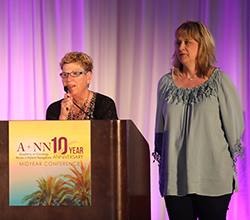
Having absorbed a great deal of new and valuable information to apply in their daily navigation tasks, conference attendees gathered one last time for closing remarks from AONN+ leaders, and then bid a fond farewell to all those with whom they connected over the weekend. Many made plans to reconvene at the 10th Annual Navigation & Survivorship Conference, November 6-10, 2019, in Nashville, TN, which promises to be the biggest and best yet, with AONN+ marking a decade of excellence and growth in the field of navigation. Be sure not to miss it—register today!
Read Midyear Highlights from Friday, May 17, 2019
Read Midyear Highlights from Saturday, May 18, 2019









